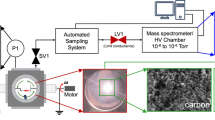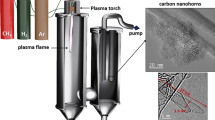Abstract
Understanding the interaction between small alkane radical ions and methane could lead to more efficient ways of hydrogen production, which is an essential component in the field of green energy. It can contribute to the development of new plasma processing methods for natural gas utilization and conversion into other useful products. In this study, using first-principles calculations we analyzed interactions between small alkane radical ions and methane molecules in low-temperature plasma resulting in formation of carbon clusters and hydrogen molecules. We found that anion-methane interaction initiates after C–H bond rupture in CH4 with the lowest activation barrier observed for negative ions C3H7− and C2H5− undergoing a hydrogen transfer reaction. Positive alkane ion radicals C3H7+ and C2H5+ demonstrated a different initial step in the clustering process where CH3 and H transfer reactions occur simultaneously. The activation barrier for the reaction between positive ethyl ion C2H5+ and methane is ~ 0.4 eV in accordance with experimental studies. Our calculations showed that both negative and positive ethyl ions readily react with methane, forming hydrogen molecules and propyl ion radicals C3H7−/ C3H7+. However, the continued growth of these radicals encounters increasing activation barriers, suggesting a slowdown in the carbon ion clustering rate and hydrogen production. Estimated rate constants of the considered ion-neutral reactions are in reasonable agreement with experimental values for a wide range of temperatures. These findings are crucial for understanding of carbon nanoparticle generation and hydrogen production using plasma catalysis.











Similar content being viewed by others
Data Availability
The data that support the findings of this study are available on request from the corresponding author, Yegor M. Kedalo.
References
Kortshagen UR, Sankaran RM, Pereira RN et al (2016) Nonthermal plasma synthesis of nanocrystals: fundamental principles, materials, and applications. Chem Rev 116:11061–11127. https://doi.org/10.1021/acs.chemrev.6b00039
Girshick SL (2020) Particle nucleation and growth in dusty plasmas: on the importance of charged-neutral interactions. J Vac Sci Technol A 38:011001. https://doi.org/10.1116/1.5136337
Bouchoule A, Plain A, Boufendi L et al (1991) Particle generation and behavior in a silane-argon low-pressure discharge under continuous or pulsed radio-frequency excitation. J Appl Phys 70:1991–2000. https://doi.org/10.1063/1.349484
Howling AA, Dorier JL, Hollenstein C (1993) Negative ion mass spectra and particulate formation in radio frequency silane plasma deposition experiments. Appl Phys Lett 62:1341–1343. https://doi.org/10.1063/1.108724
Howling AA, Courteille C, Doner JL et al (1996) From molecules to particles in silane plasmas. Pure Appl Chem 68:1017–1022. https://doi.org/10.1351/pac199668051017
Howling AA, Sansonnens L, Dorier JL, Höllenstein C (1993) Negative hydrogenated silicon ion clusters as particle precursors in of silane plasma deposition experiments. J Phys D Appl Phys 26:1003–1006. https://doi.org/10.1088/0022-3727/26/6/019
Howling AA, Sansonnens L, Dorier JL, Hollenstein C (1994) Time-resolved measurements of highly polymerized negative ions in radio frequency silane plasma deposition experiments. J Appl Phys 75:1340–1353. https://doi.org/10.1063/1.356413
Watanabe Y (2006) Formation and behaviour of nano/micro-particles in low pressure plasmas. J Phys D Appl Phys. https://doi.org/10.1088/0022-3727/39/19/R01
Kortshagen U, Bhandarkar U (1999) Modeling of particulate coagulation in low pressure plasmas. Phys Rev E - Stat Physics, Plasmas, Fluids, Relat Interdiscip Top 60:887–898. https://doi.org/10.1103/PhysRevE.60.887
Bhandarkar UV, Swihart MT, Girshick SL, Kortshagen UR (2000) Modelling of silicon hydride clustering in a low-pressure silane plasma. J Phys D Appl Phys 33:2731–2746. https://doi.org/10.1088/0022-3727/33/21/311
De Bleecker K, Bogaerts A, Gijbels R, Goedheer W (2004) Numerical investigation of particle formation mechanisms in silane discharges. Phys Rev E - Stat Physics, Plasmas, Fluids, Relat Interdiscip Top 69:16. https://doi.org/10.1103/PhysRevE.69.056409
Perrin J, Leroy O, Bordage MC (1996) Cross-sections, rate constants and transport coefficients in silane plasma chemistry. Contrib to Plasma Phys 36:3–49. https://doi.org/10.1002/ctpp.2150360102
Bao JL, Seal P, Truhlar DG (2015) Nanodusty plasma chemistry: a mechanistic and variational transition state theory study of the initial steps of silyl anion-silane and silylene anion-silane polymerization reactions. Phys Chem Chem Phys 17:15928–15935. https://doi.org/10.1039/c5cp01979f
Bao JL, Truhlar DG (2016) Silane-initiated nucleation in chemically active plasmas: Validation of density functionals, mechanisms, and pressure-dependent variational transition state calculations. Phys Chem Chem Phys 18:10097–10108. https://doi.org/10.1039/c6cp00816j
Krueger A (2010) Carbon materials and nanotechnology. Wiley, Hoboken
Bogaerts A, Tu X, Whitehead JC et al (2020) The 2020 plasma catalysis roadmap. J Phys D Appl Phys. https://doi.org/10.1088/1361-6463/ab9048
Serrano DP, Botas JÁ, Pizarro P, Gómez G (2013) Kinetic and autocatalytic effects during the hydrogen production by methane decomposition over carbonaceous catalysts. Int J Hydrogen Energy 38:5671–5683. https://doi.org/10.1016/j.ijhydene.2013.02.112
Muradov N, Smith F, T-Raissi A (2005) Catalytic activity of carbons for methane decomposition reaction. Catal Today 102–103:225–233. https://doi.org/10.1016/j.cattod.2005.02.018
Schneider S, Bajohr S, Graf F, Kolb T (2020) State of the art of hydrogen production via pyrolysis of natural gas. ChemBioEng Rev 7:150–158. https://doi.org/10.1002/cben.202000014
Deschenaux C, Affolter A, Magni D et al (1999) Investigations of CH4, C2H2 and C2H4 dusty RF plasmas by means of FTIR absorption spectroscopy and mass spectrometry. J Phys D Appl Phys 32:1876–1886. https://doi.org/10.1088/0022-3727/32/15/316
De Bleecker K, Bogaerts A, Goedheer W (2006) Detailed modeling of hydrocarbon nanoparticle nucleation in acetylene discharges. Phys Rev E - Stat Nonlinear, Soft Matter Phys 73:1–16. https://doi.org/10.1103/PhysRevE.73.026405
Benedikt J (2010) Plasma-chemical reactions: low pressure acetylene plasmas. J Phys D Appl Phys. https://doi.org/10.1088/0022-3727/43/4/043001
Stoykov S, Eggs C, Kortshagen U (2001) Plasma chemistry and growth of nanosized particles in a C2H2 RF discharge. J Phys D Appl Phys 34:2160–2173. https://doi.org/10.1088/0022-3727/34/14/312
Hong S, Berndt J, Winter J (2003) Growth precursors and dynamics of dust particle formation in the Ar/CH4 and Ar/C2H2 plasmas. Plasma Sources Sci Technol 12:46–52. https://doi.org/10.1088/0963-0252/12/1/306
Winter J, Berndt J, Hong SH et al (2009) Dust formation in Ar/CH4 and Ar/C2H2 plasmas. Plasma Sour Sci Technol. https://doi.org/10.1088/0963-0252/18/3/034010
Hiraoka K, Kebarle P (1975) Temperature dependence of bimolecular ion molecule reactions. The reaction C2H5+ + CH4 = C3H7+ + H2. J Chem Phys 63:394–397. https://doi.org/10.1063/1.431116
Do HT, Thieme G, Fröhlich M et al (2005) Ion molecule and dust particle formation in Ar/CH4, Ar/C2H2 and Ar/C3H6 radio-frequency plasmas. Contrib to Plasma Phys 45:378–384. https://doi.org/10.1002/ctpp.200510043
Ram NB, Krishnakumar E (2011) Dissociative electron attachment to methane probed using velocity slice imaging. Chem Phys Lett 511:22–27. https://doi.org/10.1016/j.cplett.2011.05.065
Perdew JP, Burke K, Ernzerhof M (1996) Generalized gradient approximation made simple. Phys Rev Lett 77:3865–3868. https://doi.org/10.1103/PhysRevLett.77.3865
Laikov DN (2005) PRIRODA 04: a quantum chemical program suite with the application of parallel computing. Russ Chem Bull IntEd 54:820–826
Dyall KG (1994) An exact separation of the spin-free and spin-dependent terms of the Dirac–Coulomb–Breit Hamiltonian. J Chem Phys 100:2118–2127. https://doi.org/10.1063/1.466508
Laikov DN (2005) A new class of atomic basis functions for accurate electronic structure calculations of molecules. Chem Phys Lett 416:116–120. https://doi.org/10.1016/j.cplett.2005.09.046
Schlegel HB (1982) Optimization of equilibrium geometries and transition structures. J Comput Chem 3:214–218. https://doi.org/10.1002/jcc.540030212
Gonzalez C, Bernhard Schlegel H (1989) An improved algorithm for reaction path following. J Chem Phys 90:2154–2161. https://doi.org/10.1063/1.456010
Zheng J, Zhao Y, Truhlar DG (2009) The DBH24/08 database and its use to assess electronic structure model chemistries for chemical reaction barrier heights. J Chem Theory Comput 5:808–821. https://doi.org/10.1021/ct800568m
Valiev M, Bylaska EJ, Govind N et al (2010) NWChem: a comprehensive and scalable open-source solution for large scale molecular simulations. Comput Phys Commun 181:1477–1489. https://doi.org/10.1016/j.cpc.2010.04.018
Seifert G, Becker S, Dietze HJ (1988) Carbon cluster ions in laser-induced plasma. Int J Mass Spectrom Ion Process 84:121–133. https://doi.org/10.1016/0168-1176(88)83031-3
Swihart MT (2000) Electron affinities of selected hydrogenated silicon clusters (SixHy, x = 1–7, y = 0–15) from density functional theory calculations. J Phys Chem A 104:6083–6087. https://doi.org/10.1021/jp000626b
Herbst E (1979) A statistical theory of three-body ion-molecule reactions. J Chem Phys 70:2201–2204. https://doi.org/10.1063/1.437775
Truhlar DG, Garrett BC, Klippenstein SJ (1996) Current status of transition-state theory. J Phys Chem 100:12771–12800. https://doi.org/10.1021/jp953748q
Acknowledgements
This work has been carried out using computing resources of the federal collective usage center Complex for Simulation and Data Processing for Mega-science Facilities at NRC “Kurchatov Institute”, http://ckp.nrcki.ru/ and was supported by the Research Center “Kurchatov Institute (order No. 1569 of July 16, 2019).
Author information
Authors and Affiliations
Contributions
NM: methodology, investigation, writing. YP: writing, methodology, validation, investigation, visualization. YK: validation, investigation, writing, visualization. AK: writing, supervision, project administration. AS: review & editing. BP: supervision, funding acquisition.
Corresponding author
Ethics declarations
Conflict of interest
The authors declare no conflict of interest.
Ethical Approval
Not applicable.
Additional information
Publisher's Note
Springer Nature remains neutral with regard to jurisdictional claims in published maps and institutional affiliations.
Supplementary Information
Below is the link to the electronic supplementary material.
Rights and permissions
Springer Nature or its licensor (e.g. a society or other partner) holds exclusive rights to this article under a publishing agreement with the author(s) or other rightsholder(s); author self-archiving of the accepted manuscript version of this article is solely governed by the terms of such publishing agreement and applicable law.
About this article
Cite this article
Polynskaya, Y.G., Matsokin, N.A., Kedalo, Y.M. et al. A Theoretical Study on the Mechanism of Small Carbon Clusters Growth in Low-Temperature Plasma. Plasma Chem Plasma Process 44, 193–209 (2024). https://doi.org/10.1007/s11090-023-10390-3
Received:
Accepted:
Published:
Issue Date:
DOI: https://doi.org/10.1007/s11090-023-10390-3




